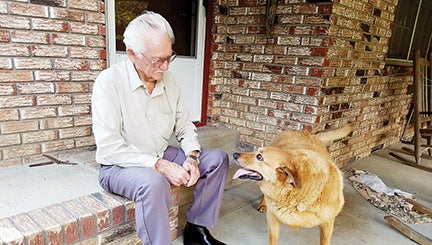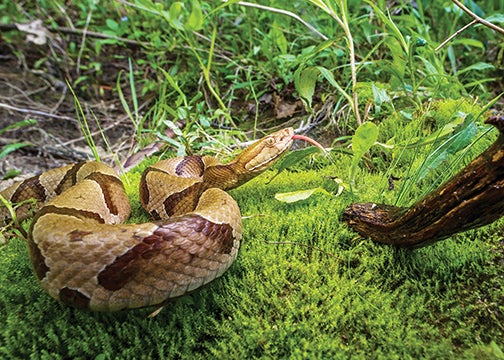Supervisor’s snake tale could save lives
Published 10:00 am Thursday, June 30, 2016

Photo by Donna Campbell/Bobby Watts, Lincoln County District 2 supervisor, with his lab, Red, sits near the front door where a cottonmouth snake bit Watts four times on the foot several years ago. Typically, most snakes encountered in Lincoln County are harmless, according to MSU Extension Service Director Rebecca Bates, and it’s important to be able to spot the venomous variety.
Bobby Watts and his aging lab, Red, haven’t seen a poisonous snake in their yard since their near-fatal encounter with a cottonmouth six years ago.
The District 2 supervisors has only seen three snakes around his property in the woods, just six miles north of the Brookhaven city limits. And only one of those — the one that bit him and his dog – was dangerous.
Snakes tend to be more visible in the summertime, said Rebecca Bates, director of the Lincoln County MSU Extension Service.
“Snakes are everywhere,” she said. “I don’t know of it being any more of a problem here than any other place.”
She said she’s received calls about snakes in people’s yards. “I have gotten a lot of calls at the office this year about snakes,” she said. “I think it’s because of the excessive rainfall. That will flush them out of the more native habitats and they can wander into our lawns.”
Typically, most snakes residents will encounter are harmless. The majority of snakes in Mississippi are water-snakes, which bears a striking resemblance to cottonmouths and are often mistaken and killed because of this.
Mississippi has a total of six venomous species. The most common three of the six are the cottonmouth, copperhead and timber rattlesnake. The other three species are the coral snake, pigmy rattlesnake and the eastern-diamondback rattlesnake.
It’s important to know the difference between non-poisonous and poisonous variety.
“You can tell by the shape of their heads,” Bates said. “Poisonous snakes will have a flat, triangular head. Other snakes have an oval, elongated head.”
Most often, snakes immediately flee when sighted. But it still pays to be careful, since even non-venomous snakes can bite you, she said.
She suggests making a lot of noise when walking in wooded, bushy areas. “I make a whole lot of noise,” she said. “The snakes are not chasing you. You normally end up stepping on them.”
That’s what happened to Watts.

Photo courtesy of Robert Lewis-MSU Extension Service/Copperheads, such as this one, are among the most common venomous snakes in Mississippi.
He was bitten four times on his foot by a cottonmouth, which is also called a water moccasin.
“When he bit me and I saw what he was, I knew I wouldn’t make it, because he’s a death baby,” he said.
The snake slithered into the house and Watts trapped it in a corner behind a door and gathered some makeshift weapons — a full can of high-powered wasp spray and a mop handle.
He whipped open the door and every time the snake opened his mouth at Watts, the man sprayed it with a heavy stream of bug spray. After a few sprays, the snake weakened enough that Watts could finish it off with the mop handle.
Then he called 911 and waited for paramedics to take him and the snake to the hospital.
Doctors acknowledged that it was, indeed, a poisonous cottonmouth whose bite is potentially fatal.
Fortunately for Watts, Red had taken the first hit.
“I came home and his head was swollen up like a lion. He got all the venom. The doctor couldn’t understand it. I wasn’t swelling up and I wasn’t turning black,” he said.
He said the dog probably saved his life.
“I wouldn’t take anything in the world for him,” he said.





